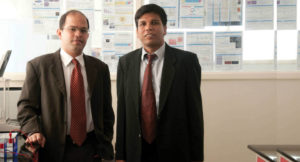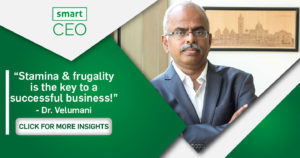With a strong focus on the therapeutic dermatological market and adaptation of the portfolio approach, Curatio Healthcare is gearing up to capitalise on a growing market and become a Rs. 400 crore revenue company by 2020.
When G.K. Ramani co-founded Curatio Healthcare (Curatio), the basic principle that he followed was to meet the unmet needs of the dermatologists. This was not the first time the serial entrepreneur used the approach as he adopted the same at his earlier stint in American Remedies, a company which was taken over by Dr. Reddy’s Laboratories. For someone with over 40 years of experience in the pharmaceutical sector identifying such needs was not a tough task. Hence, when couple of his ex-teammates came to him with ideas in the dermatology sector he immediately understood the potential. “The rise in money power, changing attitude towards aesthetic treatment, increasing awareness of diseases and the change in the dimension of treatment by dermatologists made me realise the strong potential for these ideas,” states Ramani. Soon after, Curatio Healthcare was set up in 2005, as a company that offers solutions in the area of aesthetic and therapeutic dermatology. Fulcrum Venture India, an early stage venture capital firm led by Krishna Ramanathan, co-invested in the company along with its co-founder, G.K. Ramani. More recently, Sequoia invested Rs. 100 crore as secondary on a valuation that is undisclosed.
Curatio operates in a segment which has a six per cent share in the Rs. 93,000 crore pharmaceutical market in India (approximately Rs. 5,500 crore) and expects to see this share increase in the coming years. Right from its inception, the company decided to be a strong niche player and not a me-too product player and derives its strength from its product portfolio of over 40. “While our operations started with that thinking, until about four years Curatio reached out to customers as a single team offering multiple solutions within skin care,”says Sankar Dass, chief operating officer.
In 2011, the company changed its strategy and started looking at dermatology as a whole pie and took up the therapy management approach. It classified its dermatology market into scalp care, pigmentary disorders, psoriasis care, acne management, pediatric dermatology and aligned its entire sales and marketing processes accordingly.
The driving force
Curatio’s therapy management approach is one of the key factors that set it on a growth path in the last few years. The company also scaled up its field sales staff – from 130 to 335 – during this period. Apart from its therapy management strategy, Curatio also put greater emphasis on its internal processes, systems and used technology to gather feedback from customers and act on it accordingly.
Right from metrics on finance to systems for the field force, Curatio leverages technology for business benefits, such that due diligence by big five was completed in less than 45 days.
It also decided to become a differentiated product company, which offers solutions around the chosen therapy, placing the customer in the center. “In each segment,we looked at growth driving categories,” explains Dass. Take, for instance, a condition called Acanthosis Nigericans where skin darkens around the neck. While it does not irritate or bother the patient, this is an area where even patients do not bother to seek treatment as it doesn’t appear on the face. This does not mean a suitable remedy does not exist. “We developed a product for the management of this condition. It is like creating a new need and we brought in awareness to the common man regarding this condition,” states Dass. Today, the product Canthex is growing at a rate of 45 per cent on a year-on-year basis.
The company also introduced a product called Melipox, a sprayto sooth pediatric patients with itchy skin, which mothers can spray instead of ointments as it eliminates the skin contact which can increase irritation.
In line with its philosophy of “Listen and Innovate”, the company also takes feedback from its customers to understand where it can innovate. It then takes relevant feedback and applies its commercialisation principle and finally, gives the ideas to the R&D team to develop the product.
“Right from induction, we have told our sales team not to influence through freebies to our customers, instead attract them through science and by explaining the merits of a formulation” says Dass. So how does the company find its footing with dermatologists? In an era of information overload, Curatio believes in going back to the doctors with the right information for the right product consistently as they may not have the time to read through all the available information. “This is the same logic that worked 30 years ago which we believe will work nowas the distractions are too many and consistent messaging is the only way to make an impact,” says Dass, with a lot of conviction.
The approach to market
Curatio is also looking at expanding its product portfolio and widening its geographical reach. It recently launched a sunscreen gel based on patented hydrogel technology and introduced a non-minoxidil formulation for the treatment of Telogen Effluvium (a condition that affects the scalp). It has also brought in a comprehensive skin rejuvenation formula, NEOSKIN that addresses a need of post procedure skin recovery.To help with its product development, the company has multiple tie-ups and associations with various organisations. Curatio has a tie-up with the U.S. based AMCOL to bring products based on micro-sponge technology to India; a tie-up with Italian firm Sinerga to launch haircare and de-pigmenting products in India. While it has a strong formulation research and development unit, it outsources its product manufacturing to its partners.
As far as its international markets go, Curatio has recently entered the Philippines and aims to gradually increase its share from this market, in addition to scaling up in Sri Lanka and Nepal. From the current 4 per cent to 5 per cent of its turnover, the company expects exports to contribute around 10 per cent of its total turnover, in another two years.
The path ahead
Dass is extremely confident about Curatio’s future and expresses faith in its strong product portfolio. “A dermatologist will prescribe to a patient with acne, a moisturizer specially formulated for acne prone skin and we cater to that need,” says Dass explaining why OTC products are not a competition for a company like Curatio, which is in the prescription business. It believes that its strategy to remain a niche player helps it overcome competition from other players in the industry. An increase in the number of feet-on-street sales people, product expansion, geographical expansion, increase in customer reach and a higher share in the mind of a dermatologist, have all led to Curatio’s turnover of Rs. 72 crore in FY2014-15, up from Rs. 62 crore in the corresponding previous fiscal. It expects to close the current fiscal with revenue of around Rs. 100 crore.
With clarity on their target market, the company is set to capitalise on the growing aesthetic and therapeutic dermatological market, through the organic and inorganic route. “We are working on acquisitions in the field of dermatology and at the same time pursuing new product launches with the help of our R&D team,” says Ramani. The company, however, is not looking to raise any funds. Ramani is confident of using its internal accruals to fund the growth plans of the company. With all these strategies in place, the Curatio team is working towards creating an organisation which will touch anywhere between Rs.350 crore to Rs. 400 crore in revenue by 2020.
WHAT NEXT?
? Reach a revenue of Rs.350 crore to Rs. 400 crore by 2020
? Work on acquisitions in the field of dermatology
? Pursue new product launches
? Expect export to contribute around 10 per cent of its total turnover in another two years from the current 4 per cent to 5 per cent.




